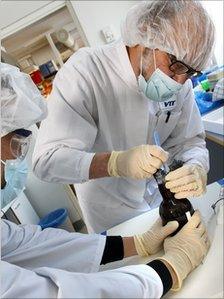Shipwreck's 'oldest beer' to be brewed again
- Published

Samples of the world's oldest beer have been taken in a bid to determine its recipe - and brew it again.
In July 2010, a Baltic Sea shipwreck dated between 1800 to 1830 yielded many bottles of what is thought to be the world's oldest champagne.
Five of the bottles later proved to be the oldest drinkable beer yet found.
The local government of the Aland island chain where the wreck was found has now commissioned a scientific study to unpick the beer's original recipe.
Divers found the two-mast ship at a depth of about 50m in the Aland archipelago, which stretches between the coasts of Sweden and Finland in the Baltic Sea.
The ship was believed to be making a journey between Copenhagen in Denmark and St Petersburg, then the capital of Russia.
The salvaging operation to bring up 145 champagne bottles - since determined to include vintages from Heidseck, Veuve Clicquot and Juglar - had one casualty: a bottle that burst open at the surface, revealing itself to be beer.
The brew has already been sampled by four professional beer tasters.
"They said that it did taste very old, which is no surprise, with some burnt notes. But it was quite acidic - which could mean there's been some fermenting going on in the bottle and with time it's become acid," said Annika Wilhelmson of the Technical Research Centre of Finland (VTT).
VTT has now been commissioned to get to the bottom of the sunken beer's recipe.
"We're going to try to see if we can find any living yeast or other microbial cells, because that would be very interesting with respect to reproducing the beer," Dr Wilhelmson explained.
"So far we have seen under microscopes that there are yeast and bacterial cells, but we don't know if they're dead or alive yet. If we can't find living microbes, we will look at the DNA and try to compare it to brewing yeasts that we know today, to see how similar or different the yeasts are."
Pinning down which hops have been used on the basis of further chemical analysis may be difficult, Dr Wilhelmson added, meaning that reviving the 200-year-old brew for modern drinkers may prove difficult.
"Whatever we analyse, we're going to have to do a lot of interpreting," she said. "We need to analyse what it is today and start thinking about what it was like when it was made - when it was fresh, because it clearly isn't fresh now."
- Published17 July 2010